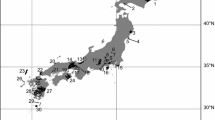Abstract
Latitudinal trends in body size have been explained as a response to temperature- or water-related factors, which are predictors of primary production. We used the first principal component calculated from three body parameters (weight, body length and the greatest length of the skull) of a sample of mammals from Israel and Sinai to determine those species that vary in size geographically, and whether such variation is related to annual rainfall, average minimum January temperature and average maximum August temperature. We used a conservative approach to discern the effects of precipitation and temperature by applying sequential regression. Variable priorities were assigned according to their bivariate correlation with body size, except for rainfall and its interactions that entered into the model last. Eleven species (Acomys cahirinus, Apodemus mystacinus, Canis lupus, Crocidura suaveolens, Gerbillus dasyurus, Hyaena hyaena, Lepus capensis, Meles meles, Meriones tristrami, Rousettus aegyptius and Vulpes vulpes) of the 17 species examined varied in size geographically. In five of them, rainfall was positively related to body size, while in one species it was negatively related to it. Contrary to the prediction of Bergmann’s rule, mean minimum January temperature was positively related to body size in five species and negatively related to body size in two species (C. suaveolens and G. dasyurus). As predicted by Bergmann’s rule, maximum June temperature was negatively related to body size in three species, and positively so in one (L. capensis). Primary production, particularly in desert and semi-desert areas, is determined mainly by precipitation. The above results indicate that, in our sample, primary production has an important effect on body size of several species of mammals. This is evident from the considerable proportion of the variability in body size explained by rain. However, low ambient temperatures may slow down and even inhibit photosynthesis. Hence, the observed positive relationships between average minimum January temperature and body size in four of the six species influenced by rain further support this conclusion.

Similar content being viewed by others
References
Ashton KG (2002a) Patterns of within species body size variation of birds: strong evidence for Bergmann’s rule. Glob Ecol Biogeogr 11:505–523
Ashton KG (2002b) Do amphibians follow Bergmann’s rule? Can J Zool 80:708–716
Ashton KG (2004) Sensitivity of intraspecific latitudinal clines for tetrapods to sampling, latitude and body size. Integ Comp Biol 44:403–412
Ashton KG, Tracy MC, de Queiroz A (2000) Is Bergmann’s rule valid for mammals? Am Nat 156:390–415
Blackburn TM, Gaston KJ, Loder N (1999) Geographic gradients in body size: a clarification of Bergmann’s rule. Divers Dist 5:165–174
Burnett CD (1983) Geographic and climate correlates on morphological variation in Eptesicus fuscus. J Mammal 64:437–444
Calder WA (1984) Size, function and life history. Harvard University Press, Cambridge
Chetboun R, Tchernov E (1983) Temporal and spatial morphological variation in Meriones tristrami (Rodentia: Gerbillidae) from Israel. J Biogeogr 30:331–351
Corbet GB (1978) The mammals of the Palearctic region: a taxonomic review. British Museum, London
Dayan T, Tchernov E, Yom-Tov Y, Simberloff D (1989) Ecological character displacement in Saharo-Arabian Vulpes: outfoxing Bergmann’s rule. Oikos 55:263–272
Freckelton RP, Harvey PH, Pagel M (2003) Bergmann rule and body size in mammals. Am Nat 161:821–825
Geist V (1987) Bergmann’s rule is invalid. Can J Zool 65:1035–1038
Graham MH (2003) Confronting multicollinearity in ecological multiple regression. Ecology 84:2809–2815
Henry CJK, Ulijaszek SJ (eds) (1996) Long-term consequences of early environment. Cambridge University press, Cambridge
Jaffe S (1988) Climate of Israel. In: Yom-Tov Y, Tchernov E (eds) The zoogeography of Israel. Junk, Dordrecht, pp 79–92
James FC (1970) Geographic size variation in birds and its relationship with climate. Ecology 51:365–390
Kolb HH (1978) Variation in size of foxes in Scotland. Biol J Linn Soc 10:291–304
Lindstrom J (1999) Early development and fitness in birds and mammals. Trend Ecol Evol 14:343–348
Mayr E (1963) Animal species and evolution. Harvard University Press, Cambridge
McNab BK (1971) On the ecological significance of Bergmann’s rule. Ecology 52:845–854
Meiri S, Dayan T (2003) On the validity of Bergmann’s rule. J Biogeogr 30:331–351
Mendelssohn H (1982) Wolves in Israel. In: Harrington FH, Paquet PC (eds) Wolves of the world. Noyes, New Jersey, pp 173–195
Mendelssohn H, Yom-Tov Y (1999) Mammalia of Israel. Israel Academy of Sciences and Humanities, Jerusalem
Nevo E (1989) Natural selection of body size differentiation in Spiny mice, Acomys. Z Saugertierkund 54:81–99
Nevo E, Beiles A, Heth G, Simson S (1986) Adaptive differentiation of body size in speciating mole rats. Oecologia 69:327–333
Rosenzweig ML (1968) The strategy of body size in mammalian carnivores. Am Midl Nat 80:299–315
Schmidt-Nielsen K (1984) Scaling: why is animal size so important? Cambridge University Press, Cambridge
Scholander PF (1955) Evolution of climatic adaptation in homoeotherms. Evolution 9:15–26
Wigginton JD, Dobson FS (1999) Environmental influences on geographic variation in body size of western bobcats. Can J Zool 77:802–813
Wilson FD (1975) Sociobiology: the new synthesis. Harvard University Press, Cambridge
Yom-Tov Y (1967) On the taxonomic status of the hares (Genus Lepus) in Israel. Mammalia 31:246–259
Yom-Tov Y (1988) The zoogeography of birds and mammals in Israel. In: Yom-Tov Y, Tchernov E (eds) The zoogeography of Israel. Junk, Dordrecht, pp 389–410
Yom-Tov Y, Nix H (1986) Climatological correlates for body size of five species of Australian mammals. Biol J Linn Soc 29:245-262
Yom-Tov Y, Tchernov E (1988) The zoogeography of Israel. Junk, Dordrecht
Acknowledgements
We wish to thank Arieh Landsman for his help in measuring the skulls, Tsila Shariv for her help at the Tel Aviv University Museum, Ronen Kadmon for providing climate data Naomi Paz for editing the article, Shai Meiri for discussion and comments on the manuscript, and Jörg Ganzhorn and two anonymous referees for very useful comments. This work was partly financed by the Israel Cohen Chair for Environmental Zoology to Y.-Y.T.
Author information
Authors and Affiliations
Corresponding author
Additional information
Communicated by Jörg Ganzhorn
Rights and permissions
About this article
Cite this article
Yom-Tov, Y., Geffen, E. Geographic variation in body size: the effects of ambient temperature and precipitation. Oecologia 148, 213–218 (2006). https://doi.org/10.1007/s00442-006-0364-9
Received:
Accepted:
Published:
Issue Date:
DOI: https://doi.org/10.1007/s00442-006-0364-9




